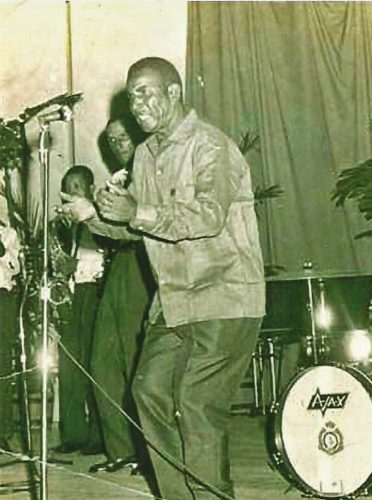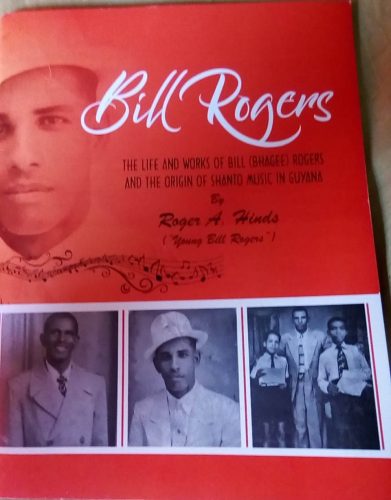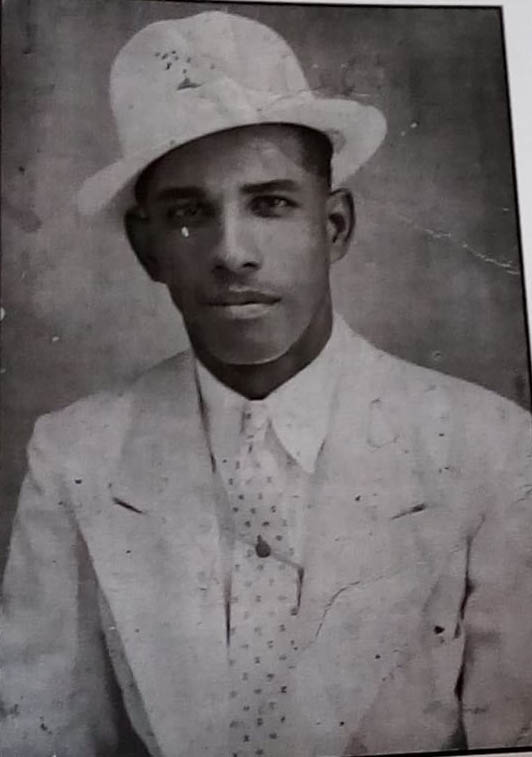As the 36th death anniversary of musical pioneer and creator of the Shanto music genre Bill Rogers approaches, the late iconic entertainer’s son, Roger ‘Young Bill Rogers’ Hinds has had his father’s biography, The Life and Works of Bill Bhagee Rogers and the Origin of Shanto Music in Guyana, reprinted.
The book was first published in 2008 by the then Ministry of Culture, Youth and Sport for Carifesta. Hinds had approached the previous government to have a reprint of the book done, but this was delayed owing to the elections earlier this year. The reprint was only completed two weeks ago. The book details the journey of the singer’s life and his work in the entertainment industry. This latest edition has an updated version of the late singer’s life.
The late Bill Rogers, a stage name he bestowed upon himself, was born Augustus Hinds on September 2, 1906. He grew up in Ketley Street, Charlestown and later became a popular promoter, magician, comedian, Shanto music composer, and singer. He died on November 21, 1984.

Unknown to many, Bill Rogers is the first Guyanese to become an international recording artiste. In 1934, he recorded with Bluebird Records, a subsidiary of RCA Victor Corporation, USA, which was considered the biggest recording company at the time. Bill Rogers was also said to be the first singer in the Caribbean to record the most original songs in the shortest period, 34 between November and December in 1934.
Among them were the hits still familiar to this day: “West Indian Weed Woman” (popularly known as the Weed Song), “BG Bhagee”, “Daddy Gone to Cove and John”, “15 Cents Sweetheart”, and “Jimmy Black Pudding and Souse”. These songs were of the Shanto genre, which is similar to Calypso.
“Shanto is a genre of music my father invented…,” his son said. “It must accentuate colloquial language and topics and must be distinctive Guyanese,” he quoted from the book.
According to his biography, Bill Rogers at five years old, wanted to sing on stage but lacked the courage. He was forced by his older sisters to perform at a ‘bottom house’ concert. Scared at first, he cried, but the desire to perform kept him there. It was the first of many stage performances. His work as an entertainer continued until late in his life.

He began performing magic tricks at the age of nine and some years later, inspired by a vendor outside of the prison who sold mauby and pancakes, Bill Rogers penned his first song, “Mauby and Pancakes”; he was only 13 years old. Outside of entertaining, he sold peppermints on the street corners.
He was 14 years old in 1920, when he composed “BG Bhagee” and four years later, founded his own troupe of entertainers called ‘The Merry Makers’. In 1926, Bill Rogers composed “West Indian Weed Woman”, which his son claims was later plagiarized by a number of other singers including the famous Jamaican-American Harry Belafonte and the late Trinidadian Calypsonian Lord Melody.
Bill Rogers was also a philanthropist as according to his biography, he coordinated scholarship fairs through which he raised funds to help less fortunate children who were unable to attend secondary school or attain an education. The first scholarship fair was held in 1952. Over the years, Hinds was able to raise $25,000 which was used to provide education for some 50 children. Some of the beneficiaries went on to excel in various fields.
Also in 1952, Bill Rogers’ recorded for the RCA Victor Bluebird Record Label, he went on to record some of the very songs he had recorded for the Parlophone and Melodisc labels which were based in the UK. Among the songs were: “Bald Plated Emily”, “Nice Woman, Ugly Man”, and “Sightseeing in the UK”. A remix of “BG Bhagee” was also done.
That very year, Bill Rogers performed at the Royal Festival Hall in London, and at City Hall in Sheffield, at the Humphrey Lyttleton Show alongside American actress, dancer, and singer Marie Bryant. He performed the remixed version of “BG Bhagee”, which brought the house down and saw an encore performance requested.
According to the biography, Bill Rogers was the first carnival promoter in British Guiana in 1937 which saw a two-day tramp through the streets of Georgetown. He was also the first to put steel bands on stage in 1947 after they were prevented from performing in the streets. Bill Rogers is recorded as the only Guyanese and outsider to have won a national competition in another country, which was the Trinidad and Tobago Calypso Monarchy in 1937. This is noted in Roots of Calypso, a book written by Trinidadian, George D Maharaj. Bill Rogers won the monarchy which included a silver trophy and TT$25 with his “West Indian Weed Woman”.
In 1935, Bill Rogers was contracted by Canadian company Kickapoo to advertise its herbs, oils, and soap. A popular promoter, the late entertainer also hosted many vaudeville shows which were a combination of various performing acts. These shows began in 1920 and continued until 1950.
In 1950, he launched the annual Baby Show, a competition judged by doctors where the healthiest baby won a trophy, a cash prize and a hamper filled with baby products. Among the judges were Dr H C Hugh and city councillor, D J Taitt.
During his lifetime, the performer/composer was the recipient of several awards. In 1935, Bill Rogers was presented a gold medal for his exceptional contribution to culture and music in British Guiana by the British government. Decades later, the Shanto creator was awarded the Medal of Service, by the Guyana government.
Bill Rogers’s last huge project was in 1972 where he did a tribute to Carifesta. He compiled his last album, a combination of ten of his songs, called ‘Shantos of Guyana’. On the recording, he was accompanied by the Guyana Police Force Band, led by saxophonist Harry Whittaker. The marathon recording was done at GBC and comprised all original songs including: “BG Bhagee”, “Bald Plated Emily”, “Metemgee, Plantain and Bhagee”, “Moving Black Sage Tree”, “That Old Rubbish Man”, “Jimmy Black Pudding and Souse”, and “Daddy Gone to Cove and John”.
Roger Hinds recalls his father spending his twilight years performing magic tricks and songs at the Queenstown RC Secondary School. During this time, Roger was only 11 years old and would often accompany his father. He said that whatever of his father’s magic tricks he learnt, it was never enough to take on stage, but that the singing talent, rubbed off well.
Bill Rogers’s voice remains golden, preserved in time for the Guyanese generations. His songs can be found on YouTube.
The Life and Works of Bill Bhagee Rogers and the Origin of Shanto Music in Guyana was written by Roger Hinds from the memories and stories told by his father. He also sourced much information from newspaper clippings kept by his late father dating as far back as 1929.
The book is being sold at $4,000 per copy and orders can be placed through Roger, who can be contacted on 617-7939.





